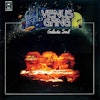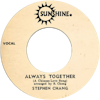Coproduced by King Curtis and Atlantic Records producer Joel Dorn, Roberta Flack’s cover of the Impressions’ “Gone Away” serves as a microcosm of the musical community around the song’s arranger and original cowriter, Donny Hathaway. Born in Chicago and raised in St. Louis, the legendary singer, songwriter, arranger, and producer attended Howard University in the mid-1960s where he roomed with a dentistry major from Newark, New Jersey: Leroy Hutson. Meanwhile, pianist and singer Roberta Flack also attended Howard then and met Hathaway via mutual friends.
Chicago soul legend Curtis Mayfield frequented Howard in those days, partly to help mentor younger musicians, party to hunt for talent—and that’s how he first came upon both Hathaway and Hutson, as they were members of the Mayfield Singers, an impromptu R&B group named in homage to the Impressions’ frontman. Mayfield had Hathaway sit in on a few gigs, and he was impressed enough to offer Hathaway a job back in Chicago to help write and arrange for Curtom Records, Mayfield’s new independent label.
At Curtom, Hathaway, alongside Mayfield and Hutson, wrote the original version of “Gone Away” for the Impressions’ 1968 album This Is My Country. Hathaway would also create masterful arrangements for the Impressions’ next album, The Young Mod’s Forgotten Story, but his days at Curtom were numbered, as he and Mayfield were perhaps too alike as musical geniuses unwilling to compromise their visions, at least not with one another.
While in Chicago, Hathaway had befriended King Curtis, who frequently came into town for session dates, and when Curtis learned that Hathaway might be looking for greener pastures, the veteran saxophonist took the news back to Atlantic Records’ Jerry Wexler. When Hathaway finally left Curtom in 1969, he signed with the ATCO subsidiary label and, by 1970, readied a debut LP for them, Everything Is Everything.
The album contained its share of Hathaway originals, including the hit “The Ghetto,” created with Hutson back in their Howard days. However, covers also dotted the LP, including a version of “I Believe to My Soul,” the Ray Charles classic about suspicious minds. On his new arrangement, Hathaway included a short but distinctive chorus melody carried on the horn section. It wasn’t so prominent that a listener would instantly notice, but the melody clearly stuck with its creator.
During the same time that he was assembling his own debut, Hathaway also played on and arranged Chapter Two, the sophomore LP by his former Howard classmate, Roberta Flack. One of the songs she chose for the album was “Gone Away,” and though the Impressions’ original was solid enough, the new version took on epic proportions. This was helped in no small way by one of the biggest changes that Hathaway provided: he lifted that fleeting horn melody from his own “I Believe to My Soul” and used it to anchor the chorus and closing section of “Gone Away.” The basic melody was little changed, but now Hathaway had the brass players repeat it for over a minute as he, Hutson, King Curtis, and Eugene McDaniels sang backup while Flack lah-lahed her way across it until the song’s fade-out.
No moment on Flack’s entire album comes close to the sheer power of this new arrangement, and over a quarter century later, Atlanta producer DJ Toomp would draw on that drama by interpolating the same melody for T.I.’s hit single on 2006’s King, “What You Know.” Hathaway and Flack would go onto bigger collaborations, beginning with their self-titled duet album in 1972, but “Gone Away” is like an easter egg of a song that briefly captured all the interpersonal overlaps—past, present, and future—in Hathaway’s tragically short but spectacular life and career.


